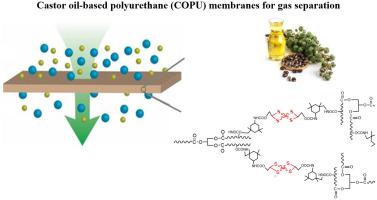Reactive & Functional Polymers ( IF 5.1 ) Pub Date : 2020-12-14 , DOI: 10.1016/j.reactfunctpolym.2020.104799 Mahsa Mansouri , Ali Ghadimi , Reza Gharibi , Somayeh Norouzbahari

|
In this paper, a new chemistry approach was developed for synthesis of castor oil (CO)-based polyurethane (PU) membranes to attain improved structural properties for gas separation applications. For this purpose, propyne-terminated CO-based PU prepolymer (PTPU) was synthesized by the reaction of CO and isophorone diisocyanate (IPDI), followed by propargyl alcohol (PrAl) and isocyanate (NCO) terminated prepolymer reaction. The ultimate membranes were prepared through thiol-yne cross-linking reaction of PTPU and pentaerythritol tetrakis (3-mercaptopropionate) (PETMP), in presence of azobisisobutyronitrile (AIBN), as a reaction initiator. It was revealed that mechanical and thermal properties of the prepared membranes were improved owing to the formation of flexible thioether linkages through cross-linking reaction. The gas permeation measurements were carried out in the temperature and pressure ranges of 298–338 K and 200–1200 kPa, respectively. The results exhibited reverse size selective performance, as a typical transport behavior of rubbery membranes. The infinite dilution permeability coefficient of CO2 at 298 K was found identical to 2.78 Barrer, along with the infinite dilution perm-selectivity values for CO2/CH4 and CO2/H2 obtained equal to 25.27 and 7.94, respectively. Furthermore, higher permeation activation energies were found in this work compared to a number of cross-linked rubbery membranes in the literature, such as poly (dimethylsiloxane) (PDMS) and poly(ethylene glycol) diacrylate (PEGDA).
中文翻译:

通过硫醇-炔-点击聚合反应合成的高度交联的蓖麻油基聚氨酯膜的透气性能
在本文中,开发了一种新的化学方法用于合成基于蓖麻油(CO)的聚氨酯(PU)膜,从而获得用于气体分离应用的改进的结构性能。为此,通过CO与异佛尔酮二异氰酸酯(IPDI)的反应,然后进行炔丙醇(PrAl)和异氰酸酯(NCO)终止的预聚物反应,合成了丙炔封端的CO基PU预聚物(PTPU)。通过在作为反应引发剂的偶氮二异丁腈(AIBN)存在下,PTPU和季戊四醇四(3-巯基丙酸酯)(PETMP)的硫醇-炔交联反应制备最终的膜。揭示了由于通过交联反应形成的柔性硫醚键,改善了制备的膜的机械和热性能。气体渗透测量分别在298–338 K和200–1200 kPa的温度和压力范围内进行。结果显示出相反的尺寸选择性能,这是橡胶膜的典型运输行为。一氧化碳的无限稀释渗透系数发现在298 K下的2与2.78 Barrer相同,并且获得的CO 2 / CH 4和CO 2 / H 2的无限稀释渗透选择性值分别等于25.27和7.94。此外,与文献中的许多交联橡胶膜相比,如聚(二甲基硅氧烷)(PDMS)和聚(乙二醇)二丙烯酸酯(PEGDA),在这项工作中发现了更高的渗透活化能。


























 京公网安备 11010802027423号
京公网安备 11010802027423号